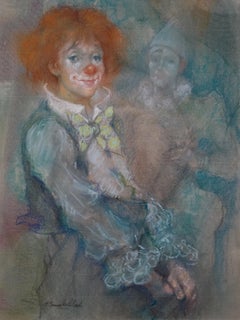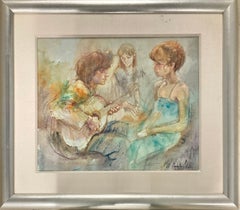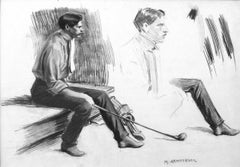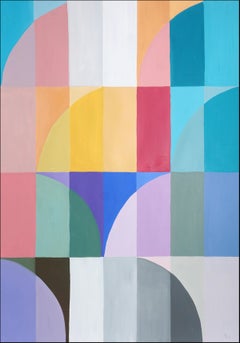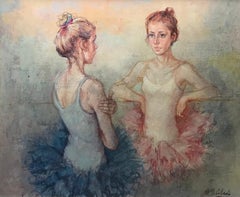Antonio Gonzalez Collado Art
Spanish, b. 1930
Antonio Gonzalez Collado was born in 1930 in Spain.
In his youth, he was a high-level gymnast. He went to Paris for a competition in 1955, fell in love with the city and captivated by the discovery of the Louvre, he promised himself to return to live there. First a student at Montparnasse 80 and at the Académie de la Grande Chaumière, he made his debut as a painter in Montmartre, place du Tertre, in 1957. In 1961, he won his first prize, the Prix de Deauville. In 1968, he was one of the painters exhibited at the Salon de Toile. The following year, it was found in the exhibition on the theme of the circus at the Musée de Montmartre. Then, he exhibited a lot in France, Belgium, Chicago and Canada.to
1
1
1
1
1
The Two Clowns (Les Deux Clowns) by Antonio Gonzalez Collado
By Antonio Gonzalez Collado
Located in Stockholm, SE
Artist: Antonio Gonzalez Collado
The Two Clowns (Les Deux Clowns)
mixed media on paper
signed
artist studio stamp on the back
dimensions (motif) 15...
Category
Late 20th Century Modern Antonio Gonzalez Collado Art
Materials
Paper, Mixed Media
Untitled
By Antonio Gonzalez Collado
Located in Warren, NJ
This is an original painting by ANTONIO GONZALEZ COLLADO. Came from a New York collector. Condition is good, however some minor staining in the matting. Measures 33x30.
Category
21st Century and Contemporary Antonio Gonzalez Collado Art
Materials
Oil
Related Items
Early 20th Century Young Golfer Figurative
By Margaret Neilson
Located in Soquel, CA
Study of a young man with his golf clubs by listed artist Margaret Neilson Armstrong (American, 1867-1944). Image, 14"H x 20"W. Displayed in vintage mat. S...
Category
1920s Realist Antonio Gonzalez Collado Art
Materials
Paper, Pencil
Color Bloom, Bauhaus Vertical Painting in Purple & Turquoise Arches Grid, Paper
By Natalia Roman
Located in Barcelona, ES
This series of abstract geometric paintings by Natalia Roman draws its inspiration from the sleek grids and curves of Bauhaus architecture, while at the same time exploring bright an...
Category
2010s Analytic Cubist Antonio Gonzalez Collado Art
Materials
Paper, Oil, Acrylic
Shattered Tiles, Red and Blue Abstract Memphis Shapes Diptych, Acrylic on Paper
By Ryan Rivadeneyra
Located in Barcelona, ES
This exquisite acrylic painting on paper draws inspiration from the modernist masters of the 1950s, 60s, and 70s, featuring a refined composition of organic, gem-like shapes. The art...
Category
2010s Analytic Cubist Antonio Gonzalez Collado Art
Materials
Paper, Oil
Early 20th century Art Deco Male nude oil painting of Narcissus
By George Frederick Hinchcliff
Located in Harkstead, GB
An incredibly striking study of the male form with the figure set against a colourful background with stylised organic forms. Attractively framed, the painting is ready to be hung an...
Category
1930s Modern Antonio Gonzalez Collado Art
Materials
Oil, Canvas
$1,552 Sale Price
29% Off
H 16 in W 20 in D 2 in
Wonderful Victorian oil of cows grazing in the Welsh or English hills
Located in Harkstead, GB
An idyllic view of cattle and sheep grazing in a pasture before an oak tree with a blue sky with bollowing clouds beyond.
William S Rose (1810-1873)
Cattle and sheep grazing in rou...
Category
Mid-19th Century Victorian Antonio Gonzalez Collado Art
Materials
Oil, Wood Panel
$1,339 Sale Price
20% Off
H 6.5 in W 9 in D 1.5 in
George Boyle Impressionist oil painting, Barbizon School of cows grazing
Located in Harkstead, GB
A superb example of a Barbizon inspired landscape painted by George Boyle, "the Catford Corot" from the late 19th Century. This very striking image shows the artist at the absolute ...
Category
Late 19th Century Impressionist Antonio Gonzalez Collado Art
Materials
Oil, Wood Panel
$2,476
H 10 in W 14 in D 2 in
Neoclassical composition of a sculptor kneeling before his statue of the Madonna
Located in Middletown, NY
An allegory of loyalty, with the subject's dog pictured seated, holding his master's chisel in his mouth; fidelity personified.
Italian School, 18th century
Ink wash in gray and bl...
Category
Mid-18th Century Italian School Antonio Gonzalez Collado Art
Materials
Laid Paper, Ink, Watercolor
$500
H 9.73 in W 7.01 in
George Boyle Impressionist oil painting, Barbizon School of cows grazing
Located in Harkstead, GB
A superb example of a Barbizon inspired landscape painted by the "Catford Corot" from the late 19th Century. This very striking image shows the artist at the absolute peak of his abi...
Category
Late 19th Century Impressionist Antonio Gonzalez Collado Art
Materials
Oil, Wood Panel
$3,346
H 15 in W 21 in D 3 in
"Path to Joy" Portrait in Ink, Gouache and Acrylic on Paper with Deckle Edge
By Kevin Snipes
Located in Philadelphia, PA
"Path to Joy" is an original piece by Kevin Snipes made from ink, gouache, and acrylic on paper. This piece measures 19.5”h x 9.25”w and is signed en verso.
Kevin Snipes (he/him) is...
Category
21st Century and Contemporary Contemporary Antonio Gonzalez Collado Art
Materials
Paper, Ink, Acrylic, Gouache
$1,800
H 19.5 in W 9.25 in
Frederick George Cotman Impressionist oil painting Suffolk river landscape
By Frederick George Cotman
Located in Harkstead, GB
An impressive, panoramic view of the River Stour looking towards Harwich and Felixstowe in Suffolk. It is very much a snapshot of times gone by with the hay barge loaded with hay.
F...
Category
19th Century Impressionist Antonio Gonzalez Collado Art
Materials
Oil, Canvas
$1,733 Sale Price
30% Off
H 21.5 in W 30 in D 2 in
Roy Connelly, contemporary British artist, Landscape with wheat stooks
Located in Harkstead, GB
A timeless snapshot of a Suffolk landscape including the wonderful and rare sight of wheat stooks. Presented in a most attractive hand made frame.
Roy connelly (Contemporary)
Wheat ...
Category
21st Century and Contemporary Contemporary Antonio Gonzalez Collado Art
Materials
Oil, Canvas
$1,171
H 8 in W 12 in D 1.5 in
Roy Connelly, contemporary British artist, Constable Country Landscape
Located in Harkstead, GB
A timeless snapshot of a Suffolk landscape looking towards Stoke by Nayland, an area where John Constable would have painted a couple of centuries before. Presented in a most attract...
Category
21st Century and Contemporary Contemporary Antonio Gonzalez Collado Art
Materials
Canvas, Oil
$1,137
H 6 in W 10 in D 1.5 in
Previously Available Items
Dancers leaning on the barre by Antonio Gonzalez Collado - Oil on canvas
By Antonio Gonzalez Collado
Located in Geneva, CH
Oil on canvas
Gilded wooden frame
73 x 84 x 4 cm
Canvas Back Artist Stamp
Signed to lower right
Category
Late 20th Century Modern Antonio Gonzalez Collado Art
Materials
Oil
H 21.26 in W 25.6 in D 0.79 in
Antonio Gonzalez Collado art for sale on 1stDibs.
Find a wide variety of authentic Antonio Gonzalez Collado art available for sale on 1stDibs. You can also browse by medium to find art by Antonio Gonzalez Collado in mixed media, oil paint, paint and more. Much of the original work by this artist or collective was created during the 20th century and is mostly associated with the modern style. Not every interior allows for large Antonio Gonzalez Collado art, so small editions measuring 12 inches across are available. Customers who are interested in this artist might also find the work of John Emanuel, Raymond Debieve, and Elisabeth Sabala. Antonio Gonzalez Collado art prices can differ depending upon medium, time period and other attributes. On 1stDibs, the price for these items starts at $723 and tops out at $1,925, while the average work can sell for $1,324.
